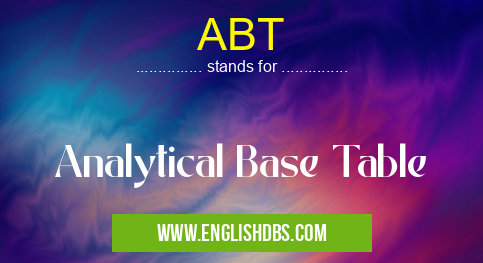What does ABT mean in DATABASES
An ABT or Analytical Base Table is a database table that stores key data used in analytical activities. It is designed to accommodate the specific requirements of analyses and reporting derived from Business Intelligence, Data Science, and other analytics domains. The ABT provides the raw material for downstream self-service analysis and also serves as a central hub for transforming, blending, and combining data sets from multiple sources while preserving the original data source characteristics.

ABT meaning in Databases in Computing
ABT mostly used in an acronym Databases in Category Computing that means Analytical Base Table
Shorthand: ABT,
Full Form: Analytical Base Table
For more information of "Analytical Base Table", see the section below.
Essential Questions and Answers on Analytical Base Table in "COMPUTING»DB"
What is an Analytical Base Table (ABT)?
An Analytical Base Table (ABT) is a master table derived from multiple source data tables, which could be used for complex data analysis or reporting. This is useful when trying to analyze large datasets with many fields and levels of aggregation.
What are some common uses of an ABT?
An ABT can be used to store data that will eventually be analyzed. It can also be used to provide a layer of abstraction between the individual source tables and the end user's queries. Furthermore, it allows for easier implementation of business logic by keeping all relevant data in one place.
How do I create an ABT?
The best way to create an ABT is to start by defining which specific tables will form part of your base table and then combine them using a query like SQL or another database language. You also need to ensure that all source tables conform to the same standards so that they can be joined and queried together. Finally, you must validate that the dataset contains no incomplete records or other inconsistencies.
What kind of information should I include in my ABT?
You should include all relevant data from each source table into your ABT. Depending on what you're trying to achieve, this could include customer demographics, purchase history, product features, etc., as long as it helps you conduct meaningful analysis or generate accurate reports. Make sure you don't add any redundant information that doesn't serve a purpose in your analysis.
What are the advantages of using an ABT?
By using an ABT instead of working with separate source tables, you gain many benefits such as improved performance for queries over large datasets; simpler integration with other systems and applications; more efficient use of resources since all operations take place in one location; and easier management and maintenance since there's no need to re-work individual source databases every time changes need to be applied or related data needs to be updated.
Does my final report always have to come from my ABT?
No, not necessarily. Although it's usually preferable if the end result comes directly from your analytical base table due its scope and comprehensiveness compared with individual source databases, you can still choose generate reports from discrete sources – either in combination with your ATB or separately – at any stage depending on your needs.
Are there any tips for creating a successful analytical base table?
Yes! For optimal results when constructing an ATB it's important to ensure high quality in its content by double-checking consistency throughout each table during importation process, making sure field labels are consistent across different databases as much as possible before joining them together; having proper documentation describing what type of data belongs where; properly normalizing entities relationships before linking them up correctly; implementing automated checks against possible discrepancies while populating fields values; etc.
Final Words:
The Analytical Base Table (ABT) plays an invaluable role in enabling efficient analytics activities such as predictive modelling, operational efficiency improvements, customer segmentation etc., across a range of industries. By providing rapid access to combinations of data elements within one single repository it helps organizations identify opportunities for improvement quickly and accurately
ABT also stands for: |
|
| All stands for ABT |
